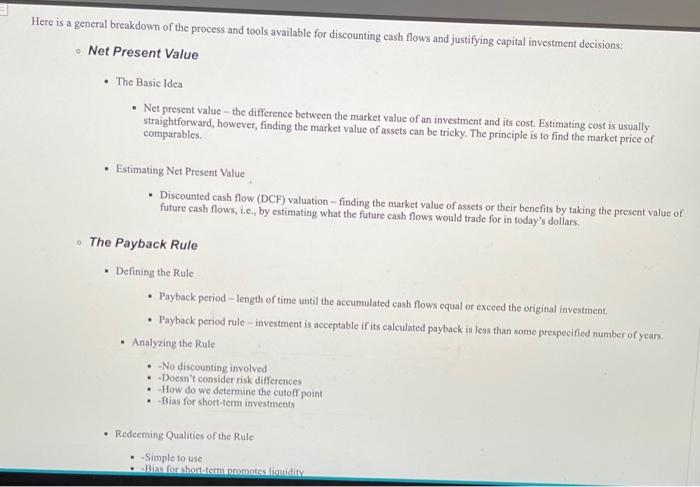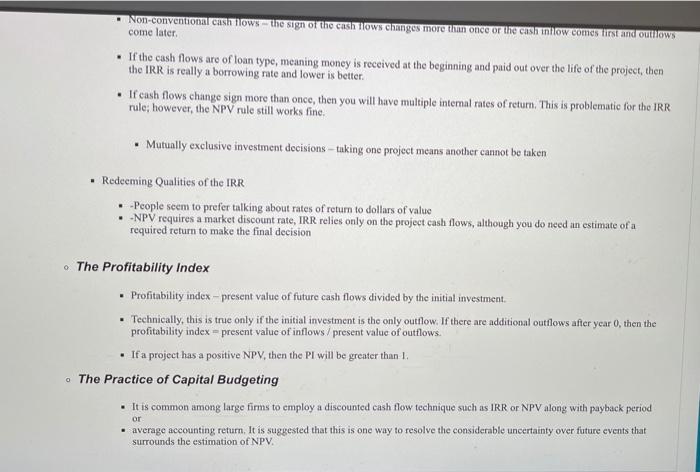rey Look at the variables in the equations on present value and future value in chapter 5 think about how these variables impact the calculations. Break down the equation and explain what the variables mean How can the understanding of the components in these calculations help you in your personal and professional lives? Here is a general breakdown of the process and tools available for discounting cash flows and justifying capital investment decisions Net Present Value The Basic ldca . Net present value - the difference between the market value of an investment and its cost. Estimating cost is usually straightforward, however, finding the market value of assets can be tricky. The principle is to find the market price of comparables. Estimating Net Present Value Discounted cash flow (DCF) valuation - finding the market value of assets or their benefits by taking the present value of future cash flows, i.e., by estimating what the future cash flows would trade for in today's dollars. The Payback Rule Defining the Rule Payback period - length of time until the accumulated cash flows equal or exceed the original investment Payback period rule - investment is acceptable if its calculated payback is less than some prespecified number of years Analyzing the Rule No discounting involved Doesn't consider risk differences How do we determine the cutoff point Bias for short-term investments . Redeeming Qualities of the Rule -Simple to use Binsfer shantasm matesidity Redeeming Qualities of the Rule -Simple to use -Bias for short-term promotes liquidity Summary of the Rule Advantages: Easy to understand Adjusts for uncertainty of later cash flows . Biased towards liquidity Disadvantages: Ignores the time value of money Requires an arbitrary cutoff point . Ignores cash flows beyond the cutoff date . Biased against long-term projects The Discounted Payback Discounted payback rule - An investment is acceptable if its discounted payback is less than some prospecified number of years, Advantages All those of the simple payback rulc, plus, the time value of money is taken into account If a project pays back on a discounted basis, and has all positive cash flows after the initial investment, then it must have a positive NPV Disadvantages The arbitrary cut-off period may eliminate projects that would increase firm value -If there are negative cash flows after the cut-off period, the rule may indicate acceptance of a project that has a negative NPV . The Average Accounting Return The average accounting return measure of accounting profit/measure of average accounting value. In other words, it is The Average Accounting Return The average accounting retur measure of accounting profit/measure of average accounting value. In other words, it is a benefit/cost ratio that produces a pseudo rate of return. However, due to the accounting conventions involved, the lack of risk adjustment and the use of profits rather than cash flows, it isn't elcar what is being measured The text gives the following specific definition: AAR average net income average book value Average accounting return rule - project is acceptable if its AAR retum exceeds a target retum Since it involves accounting figures rather than cash flows, it is not comparable to returns in capital markets -It treats money in all periods as having the same value There is no objective way to find the cutoff rate The Internal Rate of Return Internal rate of return (IRR) - the rate that makes the present value of the future cash flows equal to the initial cost or investment. In other words, the discount rate that gives a project a SO NPV IRR decision rule - the investment is acceptable if its IRR exceeds the required retum . Net present value profile - plot of an investment's NPV at various discount rates. NPV and IRR comparison: If a project's cash flows are conventional (costs are paid early and benefits are received over the life), and if the project is independent, then NPV and IRR will give the same accept or reject signal . Problems with the IRR . Non-conventional cash flows -- the sign of the cash flows chunges more than once or the cash intlow comes first and outflows come later. . If the cash flows are of loan type, meaning money is received at the beginning and paid out over the life of the project, then the IRR is really a borrowing rate and lower is better. Non-conventional cash nows the sign of the cash rows changes more than once or the cash intlow comes first and outlaws come later If the cash flows are of loan type, meaning money is received at the beginning and paid out over the life of the project, then the IRR is really a borrowing rate and lower is better. If cash flows change sign more than once, then you will have multiple internal rates of return. This is problematic for the IRR rule, however, the NPV rule still works fine. Mutually exclusive investment decisions -taking one project means another cannot be taken Redeeming Qualities of the IRR ..People seem to prefer talking about rates of return to dollars of value . NPV requires a market discount rate, IRR relies only on the project cash flows, although you do need an estimate of a required return to make the final decision The Profitability Index Profitability index - present value of future cash flows divided by the initial investment. Technically, this is true only if the initial investment is the only outflow. If there are additional outflows after year 0, then the profitability index = present value of inflows /present value of outflows. . If a project has a positive NPV, then the PI will be greater than I. The Practice of Capital Budgeting It is common among large firms to employ a discounted cash flow technique such as IRR or NPV along with payback period average accounting return. It is suggested that this is one way to resolve the considerable uncertainty over future events that Surrounds the estimation of NPV. or rey Look at the variables in the equations on present value and future value in chapter 5 think about how these variables impact the calculations. Break down the equation and explain what the variables mean How can the understanding of the components in these calculations help you in your personal and professional lives? Here is a general breakdown of the process and tools available for discounting cash flows and justifying capital investment decisions Net Present Value The Basic ldca . Net present value - the difference between the market value of an investment and its cost. Estimating cost is usually straightforward, however, finding the market value of assets can be tricky. The principle is to find the market price of comparables. Estimating Net Present Value Discounted cash flow (DCF) valuation - finding the market value of assets or their benefits by taking the present value of future cash flows, i.e., by estimating what the future cash flows would trade for in today's dollars. The Payback Rule Defining the Rule Payback period - length of time until the accumulated cash flows equal or exceed the original investment Payback period rule - investment is acceptable if its calculated payback is less than some prespecified number of years Analyzing the Rule No discounting involved Doesn't consider risk differences How do we determine the cutoff point Bias for short-term investments . Redeeming Qualities of the Rule -Simple to use Binsfer shantasm matesidity Redeeming Qualities of the Rule -Simple to use -Bias for short-term promotes liquidity Summary of the Rule Advantages: Easy to understand Adjusts for uncertainty of later cash flows . Biased towards liquidity Disadvantages: Ignores the time value of money Requires an arbitrary cutoff point . Ignores cash flows beyond the cutoff date . Biased against long-term projects The Discounted Payback Discounted payback rule - An investment is acceptable if its discounted payback is less than some prospecified number of years, Advantages All those of the simple payback rulc, plus, the time value of money is taken into account If a project pays back on a discounted basis, and has all positive cash flows after the initial investment, then it must have a positive NPV Disadvantages The arbitrary cut-off period may eliminate projects that would increase firm value -If there are negative cash flows after the cut-off period, the rule may indicate acceptance of a project that has a negative NPV . The Average Accounting Return The average accounting return measure of accounting profit/measure of average accounting value. In other words, it is The Average Accounting Return The average accounting retur measure of accounting profit/measure of average accounting value. In other words, it is a benefit/cost ratio that produces a pseudo rate of return. However, due to the accounting conventions involved, the lack of risk adjustment and the use of profits rather than cash flows, it isn't elcar what is being measured The text gives the following specific definition: AAR average net income average book value Average accounting return rule - project is acceptable if its AAR retum exceeds a target retum Since it involves accounting figures rather than cash flows, it is not comparable to returns in capital markets -It treats money in all periods as having the same value There is no objective way to find the cutoff rate The Internal Rate of Return Internal rate of return (IRR) - the rate that makes the present value of the future cash flows equal to the initial cost or investment. In other words, the discount rate that gives a project a SO NPV IRR decision rule - the investment is acceptable if its IRR exceeds the required retum . Net present value profile - plot of an investment's NPV at various discount rates. NPV and IRR comparison: If a project's cash flows are conventional (costs are paid early and benefits are received over the life), and if the project is independent, then NPV and IRR will give the same accept or reject signal . Problems with the IRR . Non-conventional cash flows -- the sign of the cash flows chunges more than once or the cash intlow comes first and outflows come later. . If the cash flows are of loan type, meaning money is received at the beginning and paid out over the life of the project, then the IRR is really a borrowing rate and lower is better. Non-conventional cash nows the sign of the cash rows changes more than once or the cash intlow comes first and outlaws come later If the cash flows are of loan type, meaning money is received at the beginning and paid out over the life of the project, then the IRR is really a borrowing rate and lower is better. If cash flows change sign more than once, then you will have multiple internal rates of return. This is problematic for the IRR rule, however, the NPV rule still works fine. Mutually exclusive investment decisions -taking one project means another cannot be taken Redeeming Qualities of the IRR ..People seem to prefer talking about rates of return to dollars of value . NPV requires a market discount rate, IRR relies only on the project cash flows, although you do need an estimate of a required return to make the final decision The Profitability Index Profitability index - present value of future cash flows divided by the initial investment. Technically, this is true only if the initial investment is the only outflow. If there are additional outflows after year 0, then the profitability index = present value of inflows /present value of outflows. . If a project has a positive NPV, then the PI will be greater than I. The Practice of Capital Budgeting It is common among large firms to employ a discounted cash flow technique such as IRR or NPV along with payback period average accounting return. It is suggested that this is one way to resolve the considerable uncertainty over future events that Surrounds the estimation of NPV. or











